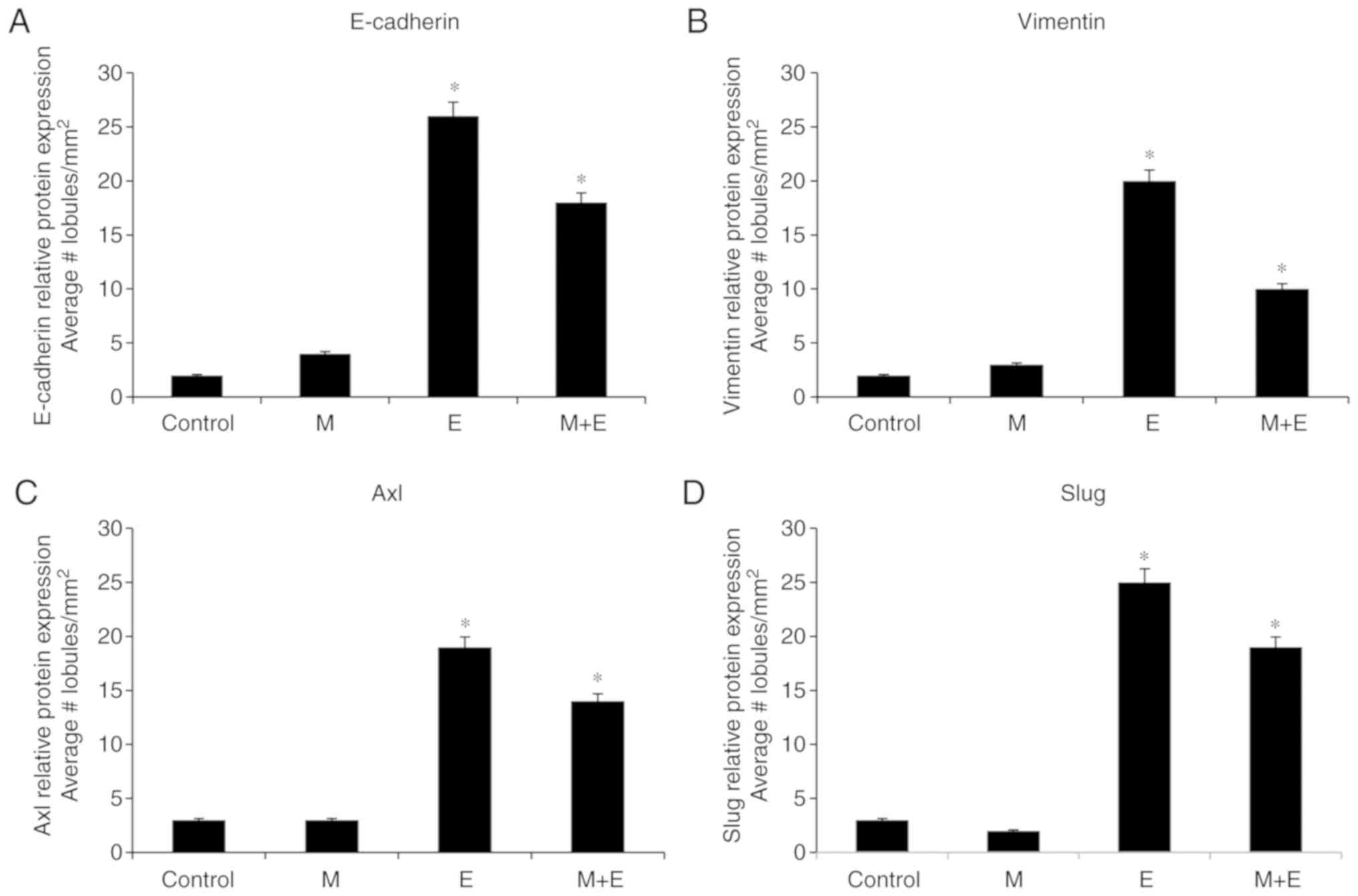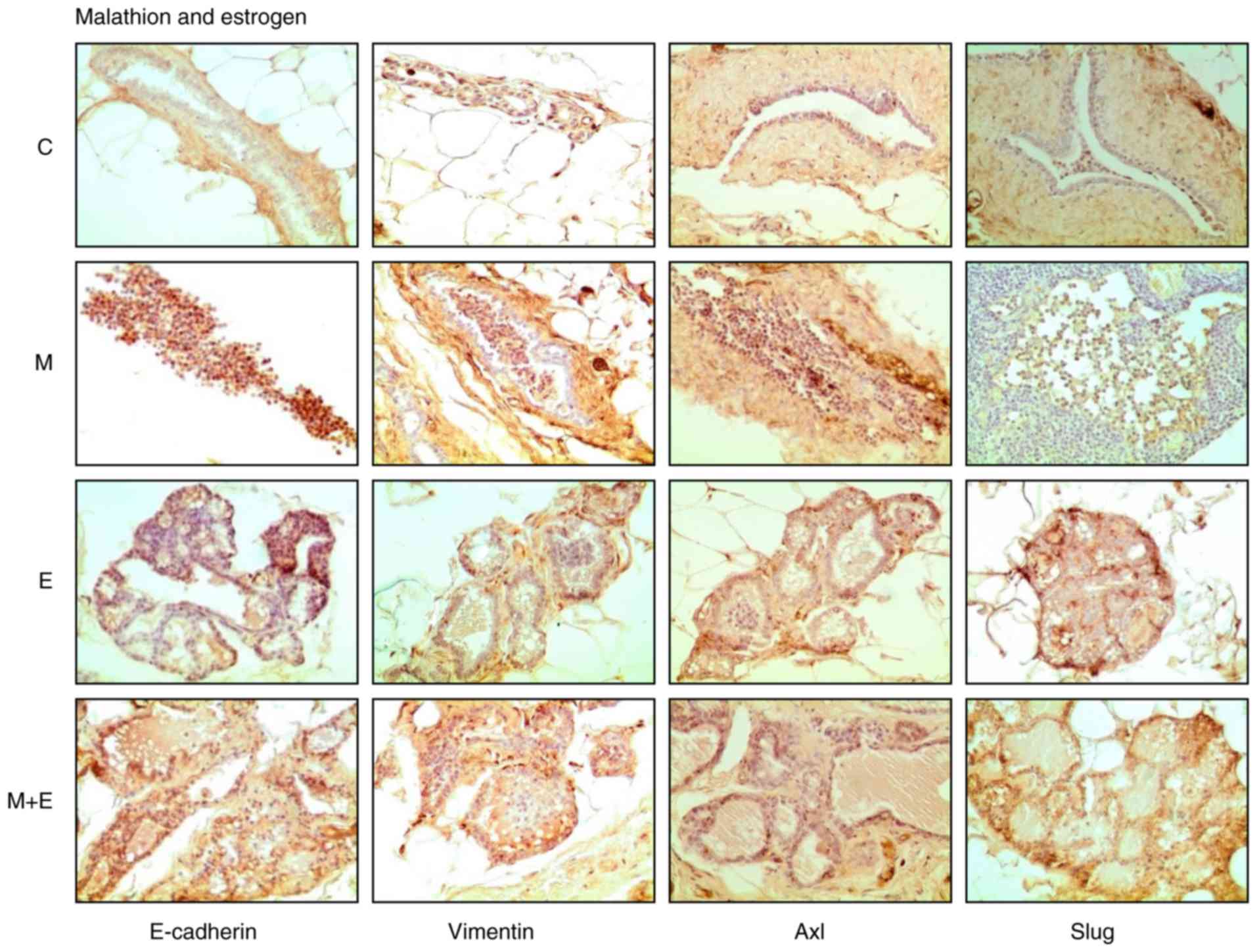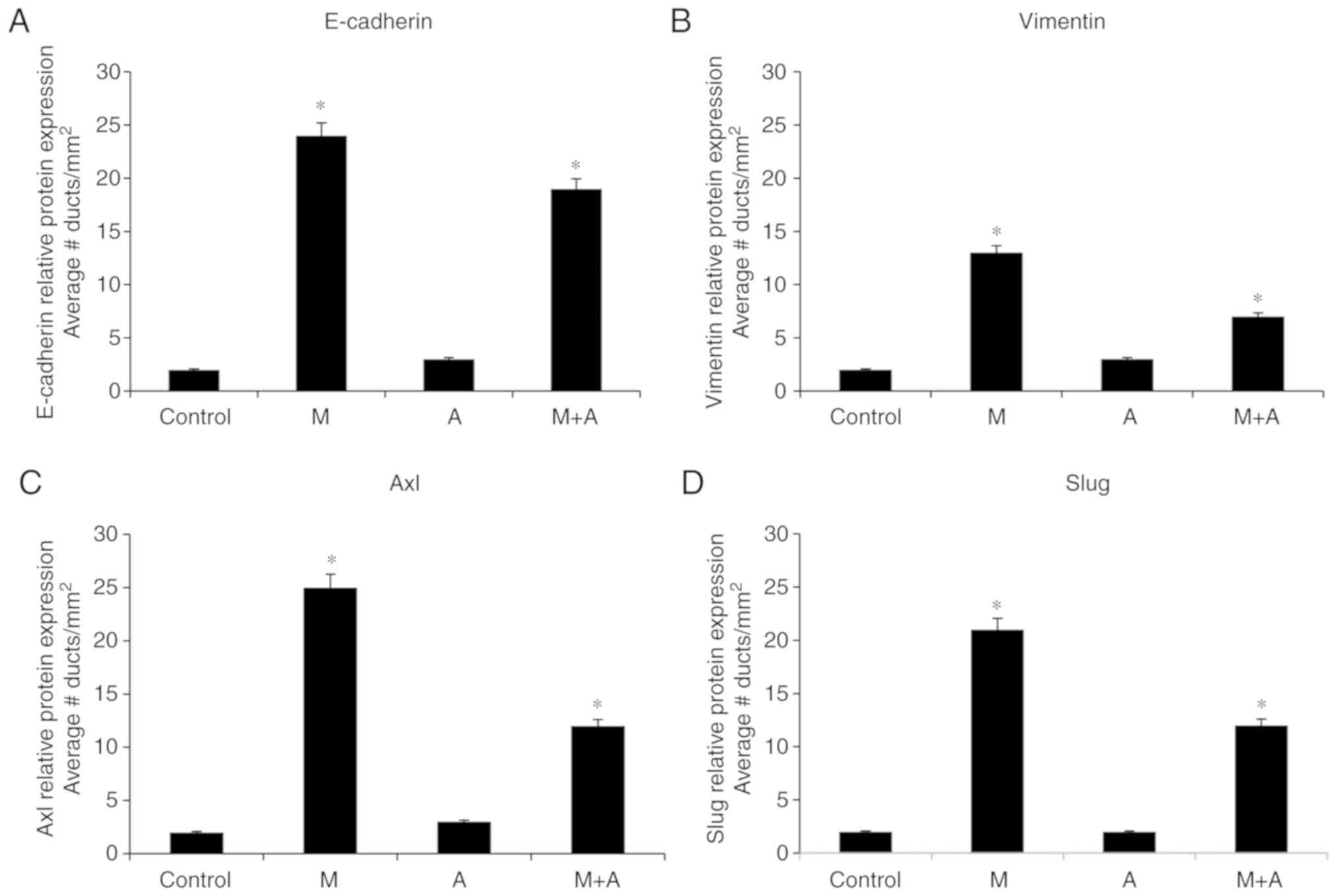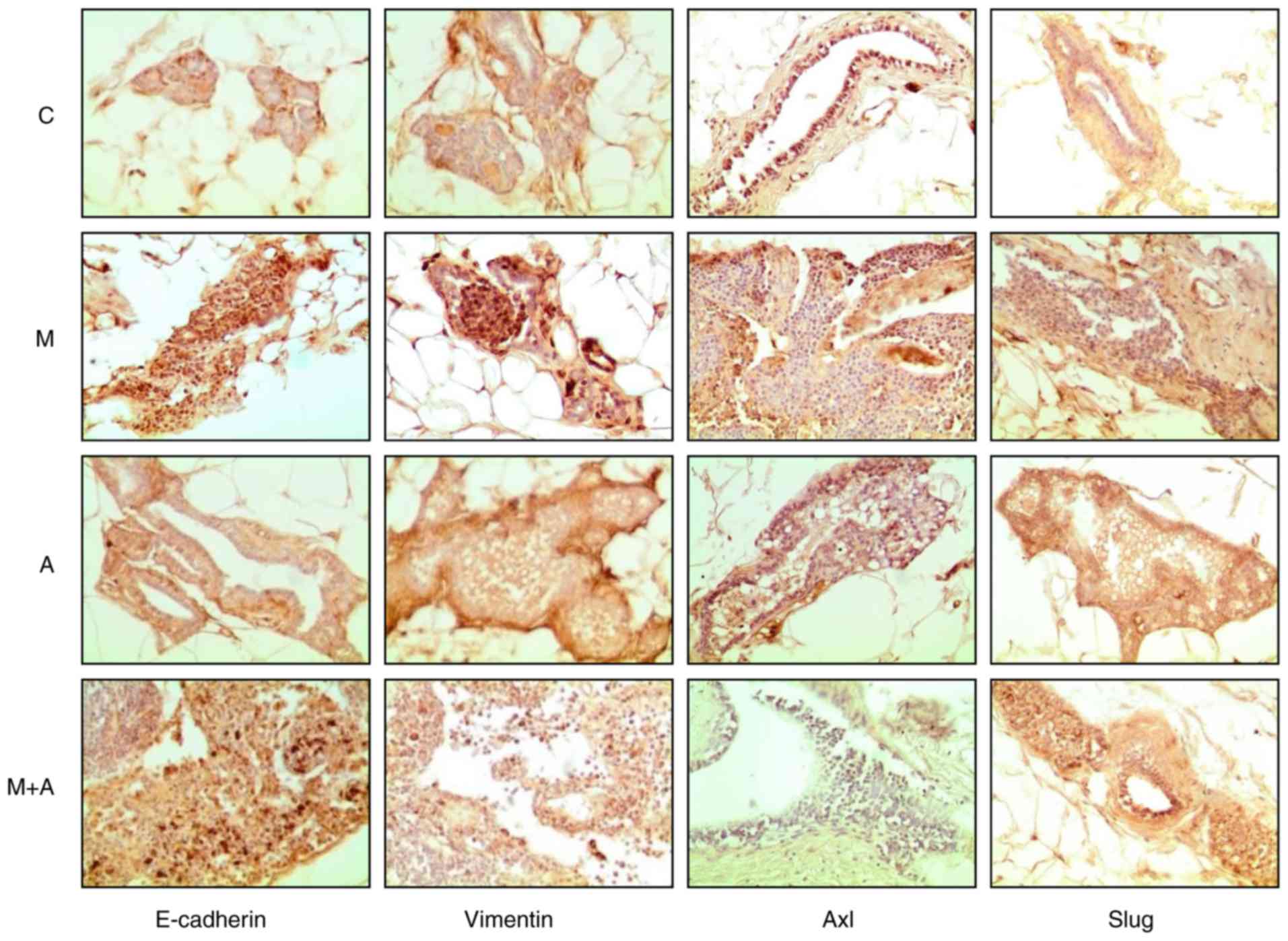|
1
|
Bray F, Ferlay J, Soerjomataram I, Siegel
RL, Torre LA and Jemal A: Global cancer statistics 2018: GLOBOCAN
estimates of incidence and mortality worldwide for 36 cancers in
185 countries. CA Cancer J Clin. 68:394–424. 2018. View Article : Google Scholar : PubMed/NCBI
|
|
2
|
Knower KC, To SQ, Leung YK, Ho SM and
Clyne CD: Endocrine disruption of the epigenome: A breast cancer
link. Endocr Relat Cancer. 21:T33–T55. 2014. View Article : Google Scholar : PubMed/NCBI
|
|
3
|
Grube A, Donaldson D, Kiely T and Wu L:
Pesticide industry sales and usage: 2006 and 2007 market estimates.
US Environmental Protection Agency. (Washington DC).
2011.Aug.
2018
|
|
4
|
EPA, . Mosquito control: Malathion. US
Environmental Protection Agency. 2014.Aug.
2018
|
|
5
|
IARC, . Agents classified by the IARC
monographs. 1-122:International Agency for Research on Cancer,
World Health Organization. (Lyon, France). 2018.Aug.
2018
|
|
6
|
De Roos AJ, Zahm SH, Cantor KP,
Weisenburger DD, Holmes FF, Burmeister LF and Blair A: Integrative
assessment of multiple pesticides as risk factors for non-Hodgkin's
lymphoma among men. Occup Environ Med. 60:E112003. View Article : Google Scholar : PubMed/NCBI
|
|
7
|
McDuffie HH, Pahwa P, McLaughlin JR,
Spinelli JJ, Fincham S, Dosman JA, Robson D, Skinnider LF and Choi
NW: Non-Hodgkin's lymphoma and specific pesticide exposures in men:
Cross-canada study of pesticides and health. Cancer Epidemiol
Biomarkers Prev. 10:1155–1163. 2001.PubMed/NCBI
|
|
8
|
Mills PK and Yang R: Prostate cancer risk
in California farm workers. J Occup Environ Med. 45:249–258. 2003.
View Article : Google Scholar : PubMed/NCBI
|
|
9
|
Pesatori AC, Sontag JM, Lubin JH, Consonni
D and Blair A: Cohort mortality and nested case-control study of
lung cancer among structural pest control workers in Florida
(United States). Cancer Causes Control. 5:310–318. 1994. View Article : Google Scholar : PubMed/NCBI
|
|
10
|
Miligi L, Costantini AS, Bolejack V,
Veraldi A, Benvenuti A, Nanni O, Ramazzotti V, Tumino R, Stagnaro
E, Rodella S, et al: Non-Hodgkin's lymphoma, leukemia, and
exposures in agriculture: Results from the Italian multicenter
case-control study. Am J Ind Med. 44:627–636. 2003. View Article : Google Scholar : PubMed/NCBI
|
|
11
|
Klaasen C: Nonmetallic environmental
toxicants: Air pollutants, solvents and vapors, and pesticides. In:
The Pharmacological Basis of Therapeutics. Goodman RT, Gilman A,
Nies AS and Taylor P: Pergamon Press Inc; New York: pp. 1615–1635.
1990
|
|
12
|
EPA, . Registration review; Draft
malathion human health risk assessment. US Environmental Protection
Agency. (Washington DC). 2016.Aug.
2018
|
|
13
|
EPA, . Revised Chlorpyrifos Human Health
Risk Assessment. US Environmental Protection Agency. (Washington
DC). 2014.http://www.regulations.gov/Aug. 2018
|
|
14
|
Bernieri T, Moraes MF, Ardenghi PG and
Basso da Silva L: Assessment of DNA damage and cholinesterase
activity in soybean farmers in southern Brazil: High versus low
pesticide exposure. J Environ Sci Health B. 55:355–360. 2020.
View Article : Google Scholar : PubMed/NCBI
|
|
15
|
Kapka-Skrzypczak L, Cyranka M, Skrzypczak
M and Kruszewski M: Biomonitoring and biomarkers of organophosphate
pesticides exposure-state of the art. Ann Agric Environ Med.
18:294–303. 2011.PubMed/NCBI
|
|
16
|
Shah HK, Sharma T and Banerjee BD:
Organochlorine pesticides induce inflammation, ROS production, and
DNA damage in human epithelial ovary cells: An in vitro study.
Chemosphere. 246:1256912020. View Article : Google Scholar : PubMed/NCBI
|
|
17
|
Guyton KZ, Loomis D, Grosse Y, El
Ghissassi F, Benbrahim-Tallaa L, Guha N, Scoccianti C, Mattock H
and Straif K; International Agency for Research on Cancer Monograph
Working Group, IARC, Lyon, France, : Carcinogenicity of
tetrachlorvinphos, parathion, malathion, diazinon, and glyphosate.
Lancet Oncol. 16:490–491. 2015. View Article : Google Scholar : PubMed/NCBI
|
|
18
|
IARC, . Some organophosphate insecticides
and herbicides. IARC Working Group on the Evaluation of
Carcinogenic Risks to Humans. 112:International Agency for Research
on Cancer. (Lyon, France). 2017.https://monographs.iarc.fr/iarc-monographs-on-the-evaluation-of-carcinogenic-risks-to-humans-4/July.
2017
|
|
19
|
Elobeid MA, Padilla MA, Brock DW, Ruden DM
and Allison DB: Endocrine disruptors and obesity: An examination of
selected persistent organic pollutants in the NHANES 1999–2002
data. Int J Environ Res Public Health. 7:2988–3005. 2010.
View Article : Google Scholar : PubMed/NCBI
|
|
20
|
Everett CJ, Frithsen IL, Diaz VA, Koopman
RJ, Simpson WM Jr and Mainous AG III: Association of a
polychlorinated dibenzo-p-dioxin, a polychlorinated biphenyl, and
DDT with diabetes in the 1999–2002 national health and nutrition
examination Survey. Environ Res. 103:413–418. 2007. View Article : Google Scholar : PubMed/NCBI
|
|
21
|
Beard J; Australian Rural Health Research
Collaboration, : DDT and human health. Sci Total Environ.
355:78–89. 2006. View Article : Google Scholar : PubMed/NCBI
|
|
22
|
Calaf GM, Parra E and Garrido F: Cell
proliferation and tumor formation induced by eserine, an
acetylcholinesterase inhibitor, in rat mammary gland. Oncol Rep.
17:25–33. 2007.PubMed/NCBI
|
|
23
|
Calaf GM and Garrido F: Catechol estrogens
as biomarkers for mammary gland cancer. Int J Oncol. 39:177–183.
2011.PubMed/NCBI
|
|
24
|
Calaf GM and Echiburu-Chau C: Synergistic
effect of malathion and estrogen on mammary gland carcinogenesis.
Oncol Rep. 28:640–646. 2012. View Article : Google Scholar : PubMed/NCBI
|
|
25
|
Echiburu-Chau C and Calaf GM: Rat lung
cancer induced by malathion and estrogen. Int J Oncol. 33:603–611.
2008.PubMed/NCBI
|
|
26
|
Alfaro-Lira S, Pizarro-Ortiz M and Calaf
GM: Malignant transformation of rat kidney induced by environmental
substances and estrogen. Int J Environ Res Public Health.
9:1630–1648. 2012. View Article : Google Scholar : PubMed/NCBI
|
|
27
|
Calaf GM and Roy D: Human drug metabolism
genes in parathion-and estrogen-treated breast cells. Int J Mol
Med. 20:875–881. 2007.PubMed/NCBI
|
|
28
|
Calaf GM and Roy D: Gene and protein
expressions induced by 17beta-estradiol and parathion in cultured
breast epithelial cells. Mol Med. 13:255–265. 2007. View Article : Google Scholar : PubMed/NCBI
|
|
29
|
Calaf GM and Roy D: Gene expression
signature of parathion-transformed human breast epithelial cells.
Int J Mol Med. 19:741–750. 2007.PubMed/NCBI
|
|
30
|
Calaf GM and Roy D: Cancer genes induced
by malathion and parathion in the presence of estrogen in breast
cells. Int J Mol Med. 21:261–268. 2008.PubMed/NCBI
|
|
31
|
Calaf GM and Roy D: Cell adhesion proteins
altered by 17beta estradiol and parathion in breast epithelial
cells. Oncol Rep. 19:165–169. 2008.PubMed/NCBI
|
|
32
|
Calaf GM, Echiburu-Chau C and Roy D:
Organophosphorous pesticides and estrogen induce transformation of
breast cells affecting p53 and c-Ha-ras genes. Int J Oncol.
35:1061–1068. 2009. View Article : Google Scholar : PubMed/NCBI
|
|
33
|
Cabello G, Valenzuela M, Vilaxa A, Duran
V, Rudolph I, Hrepic N and Calaf G: A rat mammary tumor model
induced by the organophosphorous pesticides parathion and
malathion, possibly through acetylcholinesterase inhibition.
Environ Health Perspect. 109:471–479. 2001. View Article : Google Scholar : PubMed/NCBI
|
|
34
|
Hoon Tan P, Ellis I, Allison K, Brogi E,
Fox SB, Lakhani S, Lazar AJ, Morris EA, Sahin A, Salgado R, et al:
The 2019 WHO classification of tumours of the breast.
Histopathology. Feb 13–2020.(Epub ahead of print). PubMed/NCBI
|
|
35
|
Taylor P: Anticholinesterase agents. In:
The Pharmacological Basis of Therapeutics. Goodman RT, Gilman A,
Nies AS and Taylor P: Pergamon Press Inc.; New York: pp. 131–147.
1990, PubMed/NCBI
|
|
36
|
Omran OM and Omer OH: The effects of
alpha-lipoic acid on breast of female albino rats exposed to
malathion: Histopathological and immunohistochemical study. Pathol
Res Pract. 211:462–469. 2015. View Article : Google Scholar : PubMed/NCBI
|
|
37
|
Nilsson E, Klukovich R, Sadler-Riggleman
I, Beck D, Xie Y, Yan W and Skinner MK: Environmental toxicant
induced epigenetic transgenerational inheritance of ovarian
pathology and granulosa cell epigenome and transcriptome
alterations: Ancestral origins of polycystic ovarian syndrome and
primary ovarian insufiency. Epigenetics. 13:875–895. 2018.
View Article : Google Scholar : PubMed/NCBI
|
|
38
|
Skinner MK, Manikkam M, Tracey R,
Guerrero-Bosagna C, Haque M and Nilsson EE: Ancestral
dichlorodiphenyltrichloroethane (DDT) exposure promotes epigenetic
transgenerational inheritance of obesity. BMC Med. 11:2282013.
View Article : Google Scholar : PubMed/NCBI
|
|
39
|
Kao CC, Que DE, Bongo SJ, Tayo LL, Lin YH,
Lin CW, Lin SL, Gou YY, Hsu WL, Shy CG, et al: Residue levels of
organochlorine pesticides in breast milk and its associations with
cord blood thyroid hormones and the Offspring's neurodevelopment.
Int J Environ Res Public Health. 16:14382019. View Article : Google Scholar
|
|
40
|
Chen L, Jian W, Lu L, Zheng L, Yu Z and
Zhou D: Elevated expression of E-cadherin in primary breast cancer
and its corresponding metastatic lymph node. Int J Clin Exp Med.
8:11752–11758. 2015.PubMed/NCBI
|
|
41
|
Gumbiner BM: Regulation of
cadherin-mediated adhesion in morphogenesis. Nat Rev Mol Cell Biol.
6:622–634. 2005. View
Article : Google Scholar : PubMed/NCBI
|
|
42
|
Tepass U: Genetic analysis of cadherin
function in animal morphogenesis. Curr Opin Cell Biol. 11:540–548.
1999. View Article : Google Scholar : PubMed/NCBI
|
|
43
|
Wheelock MJ and Jensen PJ: Regulation of
keratinocyte intercellular junction organization and epidermal
morphogenesis by E-cadherin. J Cell Biol. 117:415–425. 1992.
View Article : Google Scholar : PubMed/NCBI
|
|
44
|
Jeanes A, Gottardi CJ and Yap AS:
Cadherins and cancer: How does cadherin dysfunction promote tumor
progression? Oncogene. 27:6920–6929. 2008. View Article : Google Scholar : PubMed/NCBI
|
|
45
|
Shapiro L and Weis WI: Structure and
biochemistry of cadherins and catenins. Cold Spring Harb Perspect
Biol. 1:a0030532009. View Article : Google Scholar : PubMed/NCBI
|
|
46
|
Perez-Moreno M and Fuchs E: Catenins:
Keeping cells from getting their signals crossed. Dev Cell.
11:601–612. 2006. View Article : Google Scholar : PubMed/NCBI
|
|
47
|
Alves CC, Carneiro F, Hoefler H and Becker
KF: Role of the epithelial-mesenchymal transition regulator Slug in
primary human cancers. Front Biosci (Landmark Ed). 14:3035–3050.
2009. View Article : Google Scholar : PubMed/NCBI
|
|
48
|
Kim J, Bae S, An S, Park JK, Kim EM, Hwang
SG, Kim WJ and Um HD: Cooperative actions of p21WAF1 and p53 induce
Slug protein degradation and suppress cell invasion. EMBO Rep.
15:1062–1068. 2014. View Article : Google Scholar : PubMed/NCBI
|
|
49
|
Chen J, Imanaka N, Chen J and Griffin JD:
Hypoxia potentiates Notch signaling in breast cancer leading to
decreased E-cadherin expression and increased cell migration and
invasion. Br J Cancer. 102:351–360. 2010. View Article : Google Scholar : PubMed/NCBI
|
|
50
|
Hajra KM, Chen DY and Fearon ER: The SLUG
zinc-finger protein represses E-cadherin in breast cancer. Cancer
Res. 62:1613–1618. 2002.PubMed/NCBI
|
|
51
|
Wong SHM, Fang CM, Chuah LH, Leong CO and
Ngai SC: E-cadherin: Its dysregulation in carcinogenesis and
clinical implications. Crit Rev Oncol Hematol. 121:11–22. 2018.
View Article : Google Scholar : PubMed/NCBI
|
|
52
|
Liu T, Zhang X, Shang M, Zhang Y, Xia B,
Niu M, Liu Y and Pang D: Dysregulated expression of Slug, vimentin,
and E-cadherin correlates with poor clinical outcome in patients
with basal-like breast cancer. J Surg Oncol. 107:188–194. 2013.
View Article : Google Scholar : PubMed/NCBI
|
|
53
|
Myong NH: Loss of E-cadherin and
acquisition of vimentin in epithelial-mesenchymal transition are
noble indicators of uterine cervix cancer progression. Korean J
Pathol. 46:341–348. 2012. View Article : Google Scholar : PubMed/NCBI
|
|
54
|
Guarino M, Rubino B and Ballabio G: The
role of epithelial-mesenchymal transition in cancer pathology.
Pathology. 39:305–318. 2007. View Article : Google Scholar : PubMed/NCBI
|
|
55
|
Foroni C, Broggini M, Generali D and Damia
G: Epithelial-mesenchymal transition and breast cancer: Role,
molecular mechanisms and clinical impact. Cancer Treat Rev.
38:689–697. 2012. View Article : Google Scholar : PubMed/NCBI
|
|
56
|
Singh A and Settleman J: EMT, cancer stem
cells and drug resistance: An emerging axis of evil in the war on
cancer. Oncogene. 29:4741–4751. 2010. View Article : Google Scholar : PubMed/NCBI
|
|
57
|
Calaf GM, Balajee AS, Montalvo-Villagra
MT, Leon M, Daniela NM, Alvarez RG, Roy D, Narayan G and
Abarca-Quinones J: Vimentin and Notch as biomarkers for breast
cancer progression. Oncol Lett. 7:721–727. 2014. View Article : Google Scholar : PubMed/NCBI
|
|
58
|
Davidsen KT, Haaland GS, Lie MK, Lorens JB
and Engelsen AST: The role of Axl receptor tyrosine kinase in tumor
cell plasticity and therapy resistance. Biomarkers of the Tumor
Microenvironment: Basic Studies and Practical Applications. Akslen
LA and Watnick RS: Springer; Switzerland: pp. 351–376. 2017,
View Article : Google Scholar
|
|
59
|
Meyer AS, Miller MA, Gertler FB and
Lauffenburger DA: The receptor AXL diversifies EGFR signaling and
limits the response to EGFR-targeted inhibitors in triple-negative
breast cancer cells. Sci Signal. 6:ra662013. View Article : Google Scholar : PubMed/NCBI
|
|
60
|
Yanagita M, Arai H, Nakano T, Ohashi K,
Mizuno K, Fukatsu A, Doi T and Kita T: Gas6 induces mesangial cell
proliferation via latent transcription factor STAT3. J Biol Chem.
276:42364–42369. 2001. View Article : Google Scholar : PubMed/NCBI
|
|
61
|
Linger RM, Keating AK, Earp HS and Graham
DK: TAM receptor tyrosine kinases: Biologic functions, signaling,
and potential therapeutic targeting in human cancer. Adv Cancer
Res. 100:35–83. 2008. View Article : Google Scholar : PubMed/NCBI
|
|
62
|
Tai KY, Shieh YS, Lee CS, Shiah SG and Wu
CW: Axl promotes cell invasion by inducing MMP-9 activity through
activation of NF-kappaB and Brg-1. Oncogene. 27:4044–4055. 2008.
View Article : Google Scholar : PubMed/NCBI
|
|
63
|
Calaf GM: Carcinogenicity of malathion and
estrogen in an experimental rat mammary gland model. Siberian J
Oncol. 17:5–13. 2018. View Article : Google Scholar
|


















